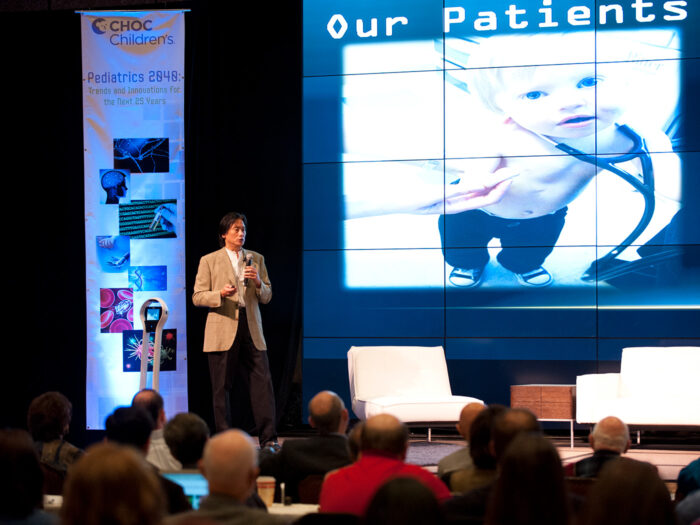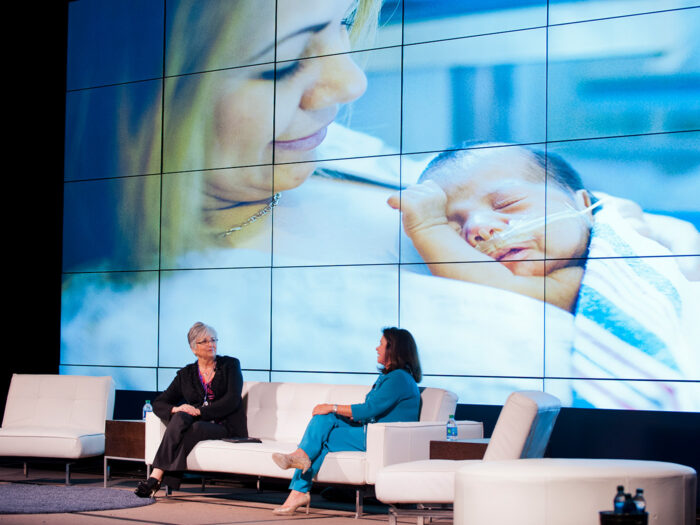CHOC experts weigh in on artificial intelligence and innovation in pediatric medicine
Robots, 3-D printing, artificial intelligence – technology of the future is expected to make life easier.
It will also have major applications in the world of pediatric medicine.
CHOC lead the way with the first Pediatrics 2040: Trends and Innovations for the Next 25 Years conference, held in Anaheim, with some of the brightest minds in health care and technology. CHOC began laying plans for Pediatrics 2040 after determining that most educational forums in medicine focus on adult diseases, with few mentions of children and their unique needs.
The highly successful conference, whose efforts were led by Dr. Anthony Chang, CHOC’s chief intelligence and innovation officer and chair of Pediatrics 2040, featured more than 50 leaders from CHOC and other leading institutions.

Over 300 participants, from as far away as Spain, attended the conference which focused on the following themes: genomic medicine, pediatric nanomedicine, robotics and robotic surgery, medical devices and mobile technology, regenerative medicine and stem cells, innovations in health care delivery and artificial intelligence and big data.
“Despite the current imbroglio of financial distress, medical errors and delivery inefficiencies in health care, the next 25 years of pediatric care hold promise to be the most exciting and rewarding,” says Dr. Chang.
Computer-assisted care, artificial intelligence impacts pediatric medicine
“AI” may stand for artificial intelligence, but “IA” stands for intelligence augmentation, according to keynote speaker Daniel Kraft, M.D. Complex knowledge systems like IBM’s Watson will be able to assist physicians in diagnosing a child’s condition, no matter how rare.
Telemedicine provides another opportunity to crowd-source patient care. Physicians can weigh in from anywhere with the use of remote devices and cameras. That means hospitals can easily enlist the help of pediatric experts, like at CHOC, to make better decisions about a child’s condition.
Researchers are taking that concept one step further with telesurgery, which will give patients access to top surgeons regardless of distance. As high-speed connections improve, surgeons will be able to use robotic tools and cloud computing to perform surgery from afar.
Robotic surgery utilized at CHOC
Robotic surgery, already in use at CHOC, is offering more dexterity to procedures in children whose small, delicate bodies require the utmost precision. Robotics continue to improve, and the addition of super senses and 3-D and 4-D ultrasound will allow for better tactile capabilities and real-time diagnoses during a procedure.
In addition to surgery, robotic technology may one day physically enhance a child’s body. Children with movement disorders or who are confined to a wheelchair may be able to wear robotic exoskeletons that help them walk and move with ease. Devices are being developed to attach to a patient’s head and interpret their thoughts, as well.

Re-building blocks in congenital defects and fatal disorders
Children with congenital defects and otherwise fatal disorders will also benefit from technological advances.
Regenerative medicine is proving to be a potential breakthrough for organ transplants. In the future, new organs and customized prosthetic limbs may be created using 3-D printers. Problems like a heart defect may be repaired using tissue engineering, rather than implanting a device that will need to be replaced as a child grows.
With the completion of the human genome project a decade ago, the health care industry is poised to use genomic medicine to predict the likelihood of disease. The latest innovations will map a child’s genes and identify their risk for illness.
If a child does become sick, advances are occurring in stem cell treatments as well as nanomedicine, which could allow hospitals to create personalized medications for a patient, leading to better outcomes.
The phone’s next phase
Smartphones are not new, but their applications in health care continue to evolve.
“We’re moving to an integration of biomedicine, information technology, wireless and, I’d say, mobile now,” Dr. Kraft says.
Mobile devices can record a child’s vital signs in an instant and may even predict whether he or she will fall sick later in the day. Mobile apps are helping pediatric patients adhere to a treatment by making it easier to perform tasks and incentivizing them to do so.
Devices like glucose monitors, stethoscopes, EKGs and microscopes are also being adapted for smartphones.
Augmented reality in children’s health
Wearable technology is prevelant, helping patients track heart rate, fitness, sleep patterns and weight.
Smaller, smarter microprocessors are proving to be useful in medicine, as well. A patient might swallow a small pill containing a microprocessor that can diagnose a condition without requiring scans, X-rays or exploratory surgery. That same pill can deliver the right medication to the right area of the body.
“We’re entering an era of miniaturization, decentralization and personalization,” Dr. Kraft says. “By pulling these things together, we can start to think about how to understand and leverage these, empower the patient, enable the doctor, enhance wellness and begin to cure the well before they get sick.”
Learn more about CHOC’s events.

Learn more about medical innovation at CHOC
The CHOC Sharon Disney Lund Medical Intelligence, Information, Investigation and Innovation Institute, known as Mi4, is the hub for innovation at CHOC. Mi4 accelerates innovation and insight that will advance the health and well-being of children.




